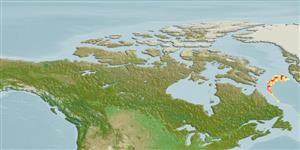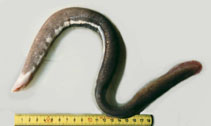Myxine jespersenae Møller, Feld, Poulsen, Thomsen & Thormar, 2005
Jespersen's hagfish
Ajouter votre observation dans Fish Watcher
| Native range | All suitable habitat | Point map | Year 2050 |

|
| This map was computer-generated and has not yet been reviewed. |
| Myxine jespersenae AquaMaps Data sources: GBIF OBIS |
Envoyez vos Photos et vidéos
Pictures | Images GoogleMyxine jespersenae
Picture by Møller, P.R.
Pictures | Images GoogleMyxine jespersenae
Picture by Møller, P.R.
Classification / Names Noms communs | Synonymes | Catalog of Fishes(Genre, Espèce) | ITIS | CoL | WoRMS | Cloffa
Myxines (hagfishes) > Myxiniformes (Hagfishes) > Myxinidae (Hagfishes) > Myxininae
Etymology: Myxine: Ancient Greek word for a slimy fish: myxa, slime; -inus, one who, referring to copious amounts of slime produced by M. glutinosa (See ETYFish); jespersenae: In honor of biologist Åse Jespersen (b. 1955), University of Copenhagen, for her contributions to the reproductive biology of hagfishes (See ETYFish).
Eponymy: Dr Åse Jespersen (d: 1955) is a Danish biologist, Associate Professor Emeritus in the Department of Biology, Marine Biological Section, Helsingør; part of the University of Copenhagen. [...] (Ref. 128868), visit book page.
Etymology: Myxine: Ancient Greek word for a slimy fish: myxa, slime; -inus, one who, referring to copious amounts of slime produced by M. glutinosa (See ETYFish); jespersenae: In honor of biologist Åse Jespersen (b. 1955), University of Copenhagen, for her contributions to the reproductive biology of hagfishes (See ETYFish).
Eponymy: Dr Åse Jespersen (d: 1955) is a Danish biologist, Associate Professor Emeritus in the Department of Biology, Marine Biological Section, Helsingør; part of the University of Copenhagen. [...] (Ref. 128868), visit book page.
Environment: milieu / climate zone / depth range / distribution range Écologie
marin bathydémersal; profondeur 752 - 1556 m (Ref. 54824). Deep-water
Distribution Pays | Zones FAO | Écosystèmes | Occurrences | Point map | Introductions | Faunafri
North Atlantic: off West Greenland, in the eastern Davis Strait. Denmark Strait, Reykjanes Ridge, and South East of Iceland. Occurs sympatrically with Myxine glutinosa, although with a rather limited overlap in vertical distribution (772-1556 vs. 64-782) and no documented capture of both species in the same haul or trap exists.
Taille / Poids / Âge
Description synthétique Clés d'identification | Morphologie | Morphométrie
Diagnosis: Color grayish brown with whitish head, the white extending posteriorly in a mid-ventral stripe of varying length; surrounding slime pores, PCD, gill aperture, cloaca, CFF, and VFF margins whitish. Two paired, pointed, or comb-shaped, bilaterally symmetrical nasal-sinus papillae with 2-5 distal fringes and 2 cusps in each row fused at their bases. Additional cusps in anterior rows 7-9 and posterior rows 8-10; total cusps 38-44. Pairs of gill pouches 6. Slime pores: prebranchial 28-37; trunk 65-74; tail 11-15; total 107-121. Body slender, depth over cloaca 2.9-4.3% TL; ventral finfold originates within anterior 10% of trunk; caudal finfold termination dorsally above cloaca to posterior 7% of trunk (Ref. 54824).
Occurs in muddy bottoms. Eggs taken from a damaged specimen in various stages of maturation , elliptical up to 23.6 X 8.5 mm; all eggs are in mesenteries and no anchor filaments were found (Ref. 54824).
Life cycle and mating behavior Maturité | Reproduction | Frai | Œufs | Fécondité | Larves
Référence principale
Upload your references | Références | Coordinateur | Collaborateurs
Møller, P.R., T.K. Feld, I.H. Poulsen, P.F. Thomsen and J.G. Thormar, 2005. Myxine jespersenae, a new species of hagfish (Myxiniformes: Myxinidae) from the North Atlantic Ocean. Copeia 2005(2):374-385. (Ref. 54824)
Statut dans la liste rouge de l'IUCN (Ref. 130435: Version 2024-2)
Préoccupation mineure (LC) ; Date assessed: 11 December 2009
CITES
Not Evaluated
Menace pour l'homme
Harmless
Utilisations par l'homme
FAO - Publication: search | FishSource |
Plus d'informations
Trophic ecology
Éléments du régime alimentaire
Composition du régime alimentaire
Consommation alimentaire
Food rations
Prédateurs
Éléments du régime alimentaire
Composition du régime alimentaire
Consommation alimentaire
Food rations
Prédateurs
Ecology
Écologie
Écologie
Population dynamics
Paramètres de croissance
Max. ages / sizes
Length-weight rel.
Length-length rel.
Fréquences de longueurs
Mass conversion
Recrutement
Abondance
Paramètres de croissance
Max. ages / sizes
Length-weight rel.
Length-length rel.
Fréquences de longueurs
Mass conversion
Recrutement
Abondance
Life cycle
Reproduction
Maturité
Maturity/Gills rel.
Fécondité
Frai
Spawning aggregations
Œufs
Développement de l'œuf
Larves
Dynamique des populations larvaires
Reproduction
Maturité
Maturity/Gills rel.
Fécondité
Frai
Spawning aggregations
Œufs
Développement de l'œuf
Larves
Dynamique des populations larvaires
Anatomy
Surface branchiale
Brain
Otolith
Surface branchiale
Brain
Otolith
Physiology
Body composition
Nutrients
Consommation d'oxygène
Type de nage
Vitesse de nage
Visual pigments
Fish sound
Diseases & Parasites
Toxicity (LC50s)
Body composition
Nutrients
Consommation d'oxygène
Type de nage
Vitesse de nage
Visual pigments
Fish sound
Diseases & Parasites
Toxicity (LC50s)
Genetics
Génétique
Heterozygosity
Héritabilité
Génétique
Heterozygosity
Héritabilité
Human related
Aquaculture systems
Profils d'aquaculture
Souches
Ciguatera cases
Stamps, coins, misc.
Aquaculture systems
Profils d'aquaculture
Souches
Ciguatera cases
Stamps, coins, misc.
Outils
E-book | Guide de terrain | Générateur de fréquences de longueur | Outil de dynamique de population | Carte par point | Classification Tree
| Catch-MSY |
Articles particuliers
Télécharger en XML
Sources Internet
AFORO (otoliths) | Aquatic Commons | BHL | Cloffa | BOLDSystems | Websites from users | FishWatcher | CISTI | Catalog of Fishes: Genre, Espèce | DiscoverLife | ECOTOX | FAO - Publication: search | Faunafri | Fishipedia | Fishtrace | GenBank: génôme, nucléotide | GloBI | Google Books | Google Scholar | Google | IGFA World Record | MitoFish | Otolith Atlas of Taiwan Fishes | PubMed | Reef Life Survey | Socotra Atlas | Arbre de Vie | Wikipedia: aller à, chercher | World Records Freshwater Fishing | Zoobank | Zoological Record
Estimates based on models
Preferred temperature (Ref. 123201): 3.4 - 4, mean 3.7 °C (based on 9 cells).
Phylogenetic diversity index (Ref. 82804): PD50 = 0.5000 [Uniqueness, from 0.5 = low to 2.0 = high].
Bayesian length-weight: a=0.00115 (0.00044 - 0.00298), b=3.03 (2.80 - 3.26), in cm total length, based on LWR estimates for this (Sub)family-body shape (Ref. 93245).
Niveau trophique (Ref. 69278): 3.4 ±0.6 se; based on size and trophs of closest relatives
Résilience (Ref. 120179): Milieu, temps minimum de doublement de population : 1,4 à 4,4 années (Preliminary K or Fecundity.).
Fishing Vulnerability (Ref. 59153): Moderate vulnerability (40 of 100).




